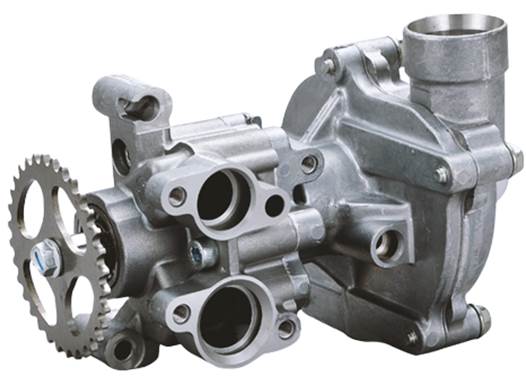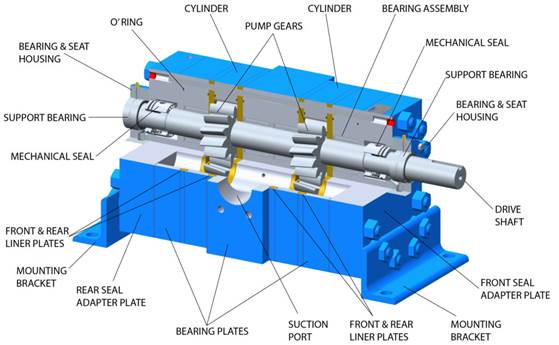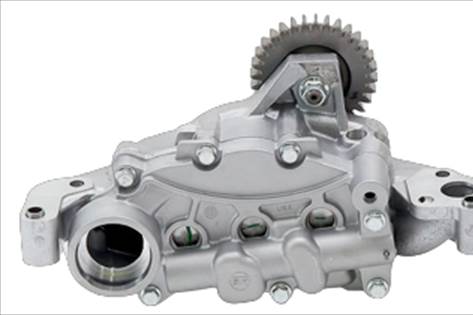Self-Priming Oil Pump
What is a self-priming oil pump?
A self-priming oil pump is a mechanical device that uses gears or lobes to circulate oil under pressure to the moving components of an engine, such as bearings, camshafts, and pistons, preventing wear and tear. It is designed to have the necessary volume of oil inside the cavity or pump body to start the pumping process. Conventional pumps require the user to manually add the requisite start-up liquid before initiating operation. Self-priming oil pump constitutes a critical part of engine lubrication systems that pump oil under pressure. This device sucks oil up from the oil pan and forces it around the oilways in the engine before the oil drops back into the sump and is recirculated. The self-priming oil pump manufacturers design the device to provide an extended service life without failure or malfunction. It must not stop working, or it will lead to expensive engine failure 100% of the time. Because of its self-priming ability, this pump can better handle air pockets, providing excellent operating efficiency.

Figure: Showing the configuration of a self-priming oil pump
Components of a self-priming oil pump
Prime mover
The prime mover is the drive force source for the self-priming oil pump. In most automobile applications, the self-priming oil pump is directly driven from the crankshaft. However, it can be rotated by a camshaft but at half the engine’s speed. When the crankshaft or the camshaft begins to turn, the pump starts working simultaneously to reduce friction and wear between moving parts and prevent the engine from seizing.
Pump casing
The pump casing, also called the housing, is the major stationary component of the self-priming oil pump. It houses the pump’s internal components. It also helps to convert the pumped liquid’s kinetic energy into the pressure head and to direct the flow to the discharge connection. The self-priming oil pump manufacturers create the pump casings from cast steel, ductile cast iron, or stainless steel.
Rotating element
Depending on the type, the rotating element can be made up of two meshing gears or a set of lobes that rotate within a tight-fitting casing. The gears or lobe help to move oil around the housing as they turn. Oil is driven into the pump by the gear teeth meshing or trapped between the opposing lobes.
Pump shaft
The shaft is a rotary cylindrical mechanical component centrally located in the pump and riding on bearings. It supports the rotating element and connects the rotor assembly to the motor via coupling.
Pressure relief valve
The pressure relief valve helps to protect the self-priming oil pump against damage due to excessive pressure. As the cold oil flows through the narrow bearing clearances, it can build up tremendous pressure (hitting 10 Psi per 1000 rpm), potentially destroying the pump. When the pressure level surpasses the value set by the self-priming oil pump manufacturer, the pressure relief valve returns the excess oil to the sump.
The inlet and outlet ports
The pumped fluid enters the pump through the inlet port and exits through the outlet port, which links with the delivery connections.
How does a self-priming oil pump work
When the engine is started, the crankshaft drives the self-priming oil pump. As the rotating element turns, a liquid seal develops within the pump casing, creating suction at the pump inlet, which causes oil to flow from a strainer into the pump. The oil is enclosed within the cavities developed between the gear teeth or trapped between opposing lobes. The trapped oil is transferred from the suction to the discharge side and then via the heat exchanger, where it is cooled. After cooling, the oil passes via the galleries to the engine’s moving components before returning to the sump. If the engine is designed with an injector, a small amount of oil is transferred to it.
Types of self-priming oil pumps
Twin gear self-priming oil pump
The twin-gear self-priming oil pump is made up of a pair of intermeshing gears. It is usually mounted at the bottom of the engine’s oil pan. The first gear (driver gear) is connected to the pump shaft and drives the second gear (driven gear). The pump shaft is connected to the crankshaft to drive the pump. The gears rotate oppositely, capturing oil between their teeth and transporting it from the pickup tube entrance to the pump outlet around the outside of each gear. The self-priming pump manufacturers fit the gears with delicate clearance to prevent the oil from flowing rearwards to the intake. This pump features small dimples at the top of the gear teeth, which store oil to keep the pump lubricated and minimize wear of gears and pump casing.
Figure: Showing a twin-gear self-priming oil pump.
Rotor self-priming oil pump
This pump comprises a rotor with four or five outer lobes that rotate inside an outer ring (referred to as a stator) with five or six interior lobes. The outer rotor always has one more lobe than the inner rotor. It is also placed slightly off-center to the inner lobe, causing the outer rotor to spin at around 80% of the internal gear’s speed. As a result, a bellows-like pumping motion takes place, helping to suck oil from the inlet port and push it to the outlet port.
Figure: Showing a rotor self-priming oil pump.
Front cover self-priming oil pump
As the name may suggest, the front cover self-priming oil pump is positioned in the front engine cover. It consists of an inner driving gear and an outer rotor, but the internal gear is directly attached to the crankshaft. This pump rotates at the same speed as the engine and thus can generate high fluid pressure. However, it has one major drawback: oil must travel a longer distance from the oil pan to the pump. This might impede oil flow for the cold and initially started engine.
Applications of a self-priming oil pump
Self-priming oil pumps are widely used in the automotive industry as engine oil pumps because engines must be adequately lubricated while operating. They are also evident in the gas and oil industry and various process plants where oil is used for a variety of repeated yet intermittent operations, such as moving products through process lines. The uses of a self-priming oil pump in automobiles include the following.
- A self-priming oil pump circulates oil in an internal combustion engine.
- It directs the oil’s passage through the galleries and to various areas.
- It returns the hot oil to the coolant oil in the reservoir.
- It is used to maintain consistent oil circulation throughout the engine.
- It is used to transfer engine lubricants under pressure to the critical components of an engine.
- It is used to ease the movement of oil around the engine.
Advantages of self-priming oil pumps
- Self-priming oil pump provides a steady pulseless stream of oil to the engine’s numerous components, boosting engine performance.
- They have excellent operation efficiency and low power consumption.
- Self-priming oil pumps are lightweight, compact, and straightforward due to a few moving parts.
- They are perfect for frequent and intermittent pumping operations, as the steps involving pump priming on start-up are eliminated.
- They can handle oil of different viscosities and
- They have a small and light construction, which can save space and weight.
- They provide cavitation-free operation.
- They are easy to install and operate.
- They are easily portable and can efficiently operate in varying configurations and environments.
- They provide a controllable oil output.
- The self-priming oil pump has a low life cycle cost. It doesn’t get servicing until it starts to fail.
Disadvantages of a self-priming oil pump
- Self-priming oil pump works against back pressure, and any blockage downstream can cause damage to the pipework or the equipment.
- The opposing and interlocking lobes and gears can produce noise.
- It can operate without the initial priming liquid in the pump’s reservoir. Dry running the pump can cause damage.
- It can be larger than the standard model due to the need for an oil reservoir.
Troubleshooting a self-priming oil pump
The pump does not deliver oil after start-up
- The relief valve has failed. Ensure the pressure setting is correct according to the electric gear oil pump manufacturer. Clean the relief valve.
- The direction of motor rotation is wrong. Ensure that the motor rotates in the direction of the arrow on the pump casing or nameplate.
- There is an air pocket in the suction line. Fill the suction line with fluid, slope the pipework upwards, and ensure there are no kinks in the suction line and that the pipework is as straight as possible.
- There is air ingress through the seal. Inspect the seals, pipework, and connected gaskets and correct or replace them if necessary.
The pump ingresses too much air
- The pump speed is low. Increase the pump speed to the level recommended by the self-priming oil pump manufacturer.
- The inlet port sealing is defective. Inspect and repair pump sealing.
- Pipe work connections are severely worn-out. Inspect, repair, or replace the pipe connections.
The pump is unable to self-prime
- The motor direction is reversed. Inspect the motor rotation direction and switch the polarities if it is necessary. Make sure that the motor rotation matches the direction of the arrow provided on the nameplate by the self-priming oil pump manufacturer.
- The lift is too high for the pump speed. Make sure you understand the suction lift requirements before selecting your pump.
- The pump is air bound. Open the valve in the air release line.
The pump is noisy
- Vibrations in safety valves. Adjust the pressure setting to the level recommended by the self-priming oil pump manufacturer or replace the safety valve if necessary.
- There is a significant pump misalignment. Inspect the pump and realign the components if necessary.
- The pump is cavitating. Reduce the pump speed and raise the fluid level in the tank. Ensure the pipes have the correct diameter following the self-priming oil pump manufacturer. Reduce the suction head and clean the filter.
- Some pump components are excessively worn-out. Inspect the rotor assembly for worn-out gears, or bearings, and replace them if necessary.
Bearings have a short life
- The rotating components are rubbing against the stationary part. Correct the pump assembly to ensure the necessary clearance.
- The shaft is bent. Inspect and replace the shaft if necessary.
- The bearings are worn-out due to the shaft running out. Replace them if necessary.
The pump is vibrating excessively
- There are unbalanced components in the pump. Inspect and rebalance the elements of a self-priming oil pump as necessary.
- The shaft is bent. Dismantle and replace the shaft if necessary.
- The impeller is severely worn-out. Inspect and replace the impeller with another one from the self-priming oil pump manufacturer.
- The pump shaft is oblique or unbalanced. Inspect the post, rebalance it as required, or replace it.
Summary
A self-priming oil pump is a mechanical device that circulates oil under pressure to an engine’s moving components to prevent wear and tear. The self-priming oil pump manufacturers develop the pump always to hold the requisite oil inside the pump body to start the pumping process. The self-priming oil pump is a vital part of the engine lubrication systems that pump oil under pressure. It sucks oil up from the oil pan and forces it around the oilways in the engine before the oil drops back into the sump and is recirculated. The pump is engineered to provide a long service life without failure or malfunction, preventing expensive engine breakdowns. A major application of a self-priming oil pump is in automobiles as an engine oil pump to keep the engine adequately lubricated during operation. Self-priming oil pump provides a steady and controllable oil output and is easy to operate because manual priming steps are eliminated.


